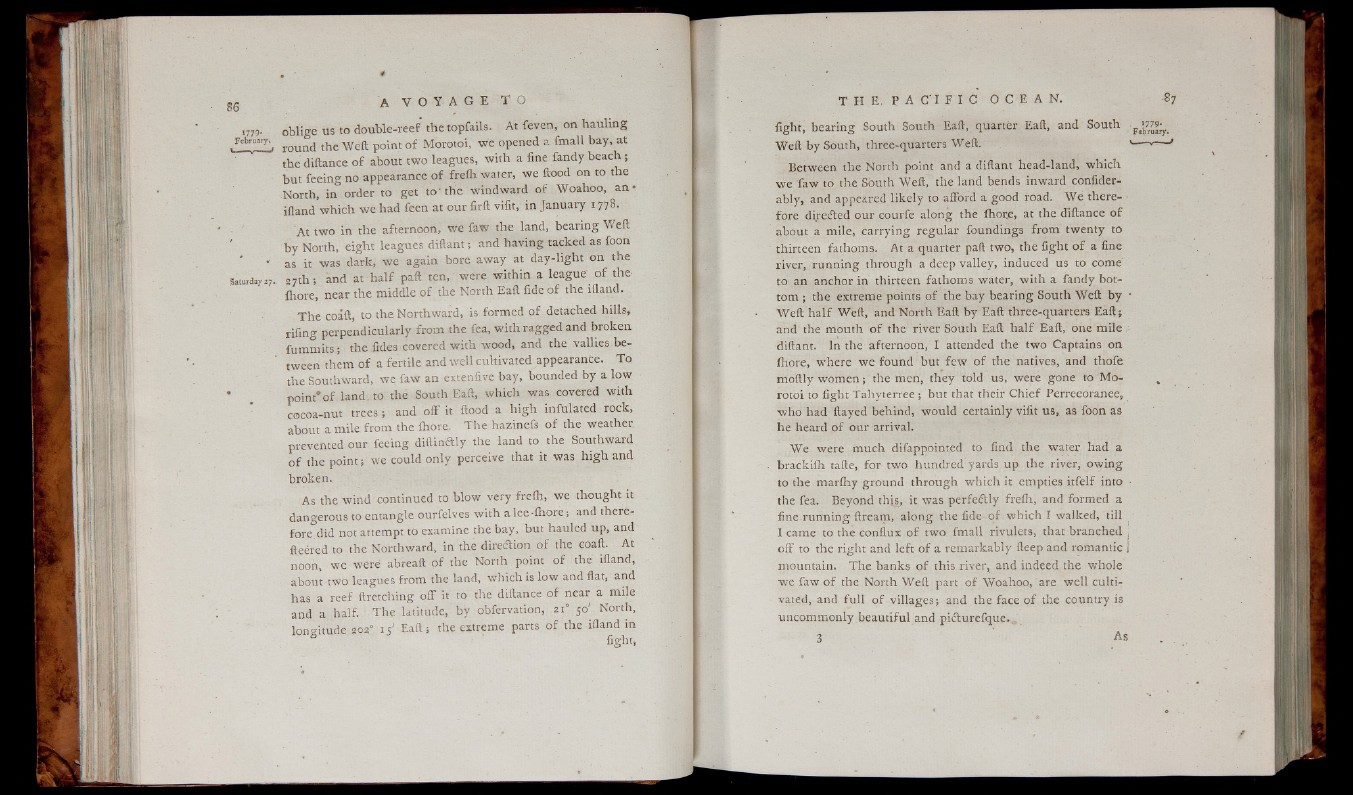
«779- oblige U s to double-reef the topfails. At feven, on h a u lin g
J ebruary', round the W eft point o f Morotoi, w e opened a fmall b a y , at
the diftance o f about two leagues, w ith a fine fandy b e a c h ;
b u t fee ing no appearance o f fre ih water, w e ftood on to the
North, in order to g e t to ’ the windward o f Woahoo, an*
ifland w h ich w e had feen at our firft vifit, in January 1778.
At two in the afternoon, w e faw the land, bearing Weft
b y North, eight lea gu es d iftan t; and h a v in g tacked as foon
* as it was dark, w e a gain bore awa y at d a y -ligh t on the
Saturday 27. 2 7 th ; and at h a lf paft ten, were with in a le a g u e o f the-
ihore, near the middle o f the North Eaft fide o f the ifiand.
T h e coaft, to the Northward, is formed o f detached hills,
rifing perpendicularly from the fea, with ra gg ed and broken
fum m its ; the fides covered w ith wood, and the vallies between
them o f a fertile and well cultivated appearance. To
the Southward, we faw an extenfive bay, bounded b y a low
' . poin t*o f land, to the South Eaft, w h ich was covered with
cocoa-nut trees ; and o ff it ftood a h ig h infu lated rock,
about a mile from the ihore, T h e hazinefs o f the weather,
prevented our feeing d iftin ftly the land to the Southward
o f the point; we could on ly perceive that it was h ig h and
broken.
As the wind continued to blow ve ry freih, w e thought it
dangerous to entangle ourfelves w ith a le e - ih o r e ; and therefore
did not attempt to examine the bay, but hauled up, and
fleered to the Northward, in the direction o f the coaft. At
noon, we were abreaft o f the North point o f the ifland,
about two leagues from the land, which is low and flat, and
has a re e f ftretching o ff it to the diftance o f near a mile
and a half. T h e latitude, by obfervation, z i° 50' North,
longitude 202° 15' Eaft; the extreme parts o f the ifland in
fight, bearing South South Eaft, quarter Eaft, and South ^ ‘¿79.^
Weft b y South, three-quarters Weft. '---- -----
Between the North point and a diftant head-land, which
w e faw to the South Weft, the land bends inward confider-
ably, and appeared lik e ly to afford a good road. We there- •
fore directed our courfe a lon g the ihor.e, at the diftance o f
about a mile, ca rryin g re gu la r foundings from twenty to
thirteen fathoms. At a quarter paft two, the fight o f a fine
river, ru n n in g throu gh a deep v a lle y , induced us to come
to an anchor in thirteen fathoms water, w ith a fandy bottom
; the extreme points o f the bay b earing South Weft b y •
Weft h a lf Weft, and North Eaft b y Eaft three-quarters Eaft;
and the mouth o f the river South Eaft h a lf Eaft, one mile
diftant. In the afternoon, I attended the two Captains on
ihore, where w e found but few o f the natives, and thofe
moftly w om en ; the men, the y told us, were gone to Mo- ,
rotoi to fight T ah y te r r e e ; but that their C h ie f Perreeoranee,
w ho had flayed behind, wou ld certainly vifit us, as foon as
he heard o f our arrival.
We were much difappoitited to find the water had a
b ra ck ifli tafte, fo r two hundred yards up the river, ow in g
to the marftiy ground throu gh w h ich it empties it fe lf into
the fea. Beyond this, it was p e r fe ftly freih, and formed a
fine running-ftream, a lon g the fide o f w hich I walked, till
I came to the conflux o f two fmall rivulets, that branched ,
o ff to the right and left o f a rema rkab ly fteep and romantic j
mountain. T h e banks o f this river, and indeed the whole
w e faw o f the North Weft part o f Woahoo, are w e ll cultivated,
and fu ll o f v illa g e s ; and the face o f the country is
uncommonly beautiful and pi£turefque. 0